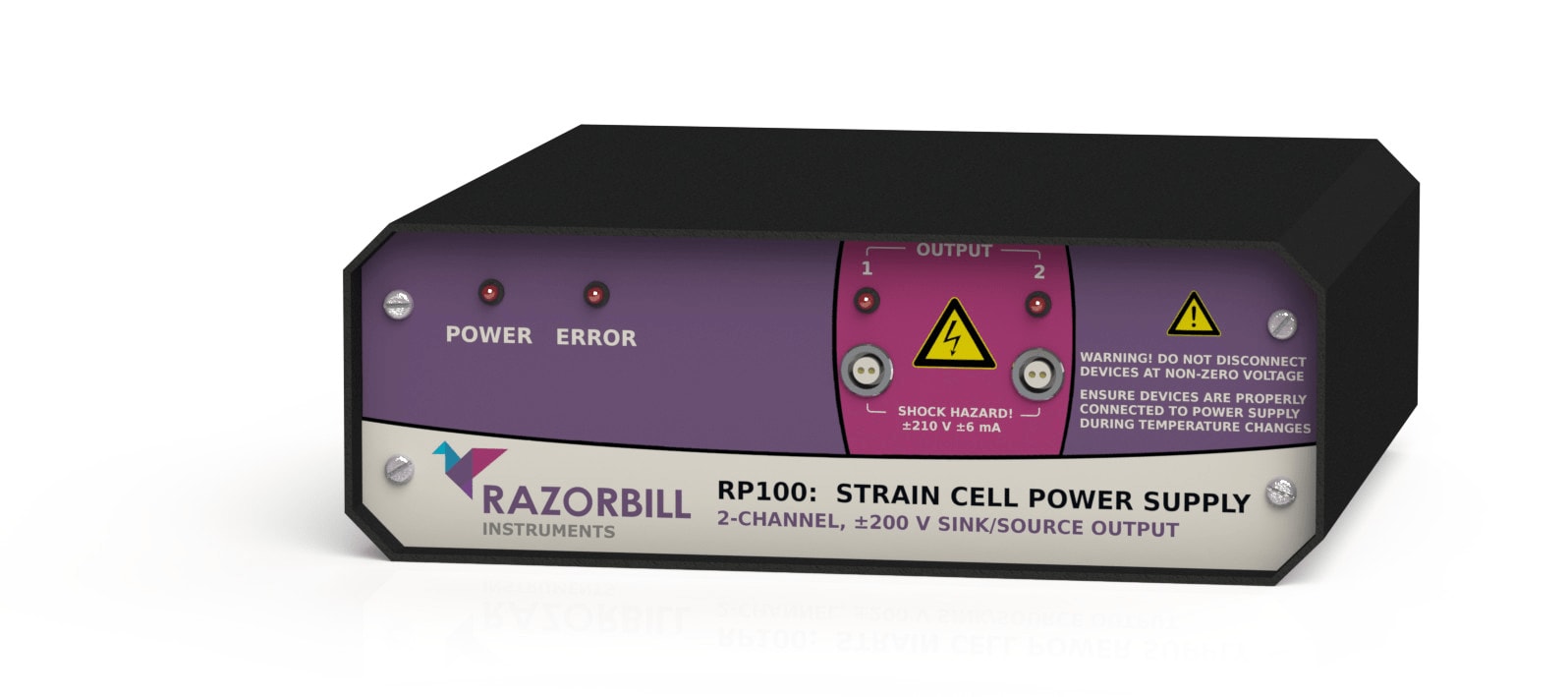Connecting to Razorbill RP100 by Razorbill in Python
Instrument Card
The RP100 is a two channel, sink-source power supply designed to drive the CS100 series strain cells and the FC100 series stress cells. This power supply can be used in conjunction with the corresponding range of compatible Razorbill Instruments products to tune the electronic properties of materials by applying controlled strains and stresses to the material.

Device Specification: here
Manufacturer card: RAZORBILL

Manufacturer of precision instruments intended for use in fundamental physics and space applications. The company manufactures electromechanical mechanisms to apply tunable uniaxial strains at low temperatures and high magnetic fields and provides expertise in the field of design for cryogenic environments, compliant mechanisms and compact systems for applying and measuring strain, enabling clients to incorporate a number of unique key technologies that allow them to have such high performance and repeatability.
- Headquarters: Edinburgh, United Kingdom
- Yearly Revenue (millions, USD): 5
- Vendor Website: here
Demo: Measure a solar panel IV curve with a Keithley 2400
Connect to the Razorbill RP100 in Python
Read our guide for turning Python scripts into Flojoy nodes.
PROTOCOLS > SCPI
from pymeasure.instruments import Instrumentfrom pymeasure.instruments.validators import (strict_discrete_set, strict_range)
class razorbillRP100(Instrument): """Represents Razorbill RP100 strain cell controller
.. code-block:: python
scontrol = razorbillRP100("ASRL/dev/ttyACM0::INSTR")
scontrol.output_1 = True # turns output on scontrol.slew_rate_1 = 1 # sets slew rate to 1V/s scontrol.voltage_1 = 10 # sets voltage on output 1 to 10V
"""
output_1 = Instrument.control("OUTP1?", "OUTP1 %d", """Turns output of channel 1 on or off""", validator=strict_discrete_set, values={True: 1, False: 0}, map_values=True)
output_2 = Instrument.control("OUTP2?", "OUTP2 %d", """Turns output of channel 2 on or off""", validator=strict_discrete_set, values={True: 1, False: 0}, map_values=True)
voltage_1 = Instrument.control("SOUR1:VOLT?", "SOUR1:VOLT %g", """Sets or queries the output voltage of channel 1""", validator=strict_range, values=[-230, 230])
voltage_2 = Instrument.control("SOUR2:VOLT?", "SOUR2:VOLT %g", """Sets or queries the output voltage of channel 2""", validator=strict_range, values=[-230, 230])
slew_rate_1 = Instrument.control( "SOUR1:VOLT:SLEW?", "SOUR1:VOLT:SLEW %g", """Sets or queries the source slew rate in volts/sec of channel 1""", validator=strict_range, values=[0.1 * 10e-3, 100 * 10e3] )
slew_rate_2 = Instrument.control( "SOUR2:VOLT:SLEW?", "SOUR2:VOLT:SLEW %g", """Sets or queries the source slew rate in volts/sec of channel 2""", validator=strict_range, values=[0.1 * 10e-3, 100 * 10e3] )
instant_voltage_1 = Instrument.measurement( "SOUR1:VOLT:NOW?", """Returns the instantaneous output of source one in volts""" )
instant_voltage_2 = Instrument.measurement( "SOUR2:VOLT:NOW?", """Returns the instanteneous output of source two in volts""" )
contact_voltage_1 = Instrument.measurement( "MEAS1:VOLT?", """Returns the Voltage in volts present at the front panel output of channel 1""" )
contact_voltage_2 = Instrument.measurement( "MEAS2:VOLT?", """Returns the Voltage in volts present at the front panel output of channel 2""" )
contact_current_1 = Instrument.measurement( "MEAS1:CURR?", """Returns the current in amps present at the front panel output of channel 1""" )
contact_current_2 = Instrument.measurement( "MEAS2:CURR?", """Returns the current in amps present at the front panel output of channel 2""" )
def __init__(self, adapter, name="Razorbill RP100 Piezo Stack Powersupply", **kwargs): super().__init__( adapter, name, **kwargs ) self.timeout = 20This code defines a class razorbillRP100 that represents a Razorbill RP100 strain cell controller. It inherits from the Instrument class provided by the pymeasure.instruments module.
The class provides various control and measurement properties for interacting with the Razorbill RP100 power supply. Here’s a breakdown of the properties:
output_1: A control property that turns the output of channel 1 on or off. It accepts a boolean value and maps it to 1 or 0 in the command string.output_2: Similar tooutput_1, but for channel 2.voltage_1: A control property that sets or queries the output voltage of channel 1. It accepts a float value within the range [-230, 230].voltage_2: Similar tovoltage_1, but for channel 2.slew_rate_1: A control property that sets or queries the source slew rate in volts/sec of channel 1. It accepts a float value within the range [0.1 * 10e-3, 100 * 10e3].slew_rate_2: Similar toslew_rate_1, but for channel 2.instant_voltage_1: A measurement property that returns the instantaneous output of source one in volts.instant_voltage_2: Similar toinstant_voltage_1, but for source two.contact_voltage_1: A measurement property that returns the voltage in volts present at the front panel output of channel 1.contact_voltage_2: Similar tocontact_voltage_1, but for channel 2.contact_current_1: A measurement property that returns the current in amps present at the front panel output of channel 1.contact_current_2: Similar tocontact_current_1, but for channel 2.
The razorbillRP100 class also has an __init__ method that initializes the instrument with the provided adapter and sets a timeout of 20 seconds.